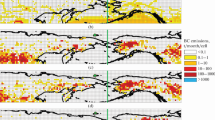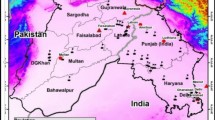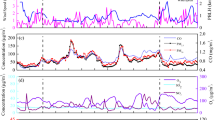Abstract
This study investigates the truth behind conversations on stubble burning (SB) contribution to Delhi’s air pollution (DAP) using ground observations, geophysical models, and satellite-based measurements during 2019 and 2020. Pieces of evidence from ground-based measurements showed a drastic increase in the pollutant concentration during the SB episode (October–November of each year), which leads to the increased air quality index (AQI), confirming the significant contribution of SB in DAP along with internal sources. Geophysical models, including Hybrid Single-Particle Lagrangian Integrated Trajectory (HYSPLIT) back trajectories and Navy Aerosol Analysis and Prediction System (NAAPS), also indicated the contribution of regional SB in DAP. Measurements from Moderate Resolution Imaging Spectroradiometer (MODIS), Visible Infrared Imagine Radiometer Suite (VIIRS), and Sentinel-P5 satellites further strengthen our findings on the regional contribution of SB, majorly from Punjab and Haryana in DAP. Nevertheless, the meteorological conditions (derived both from ground and satellite) worsen the situation of pollution in Delhi during winter.
Graphical Abstract
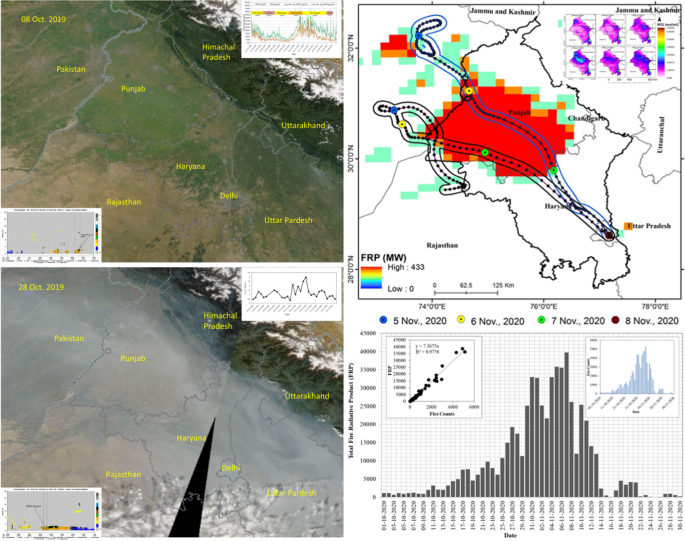
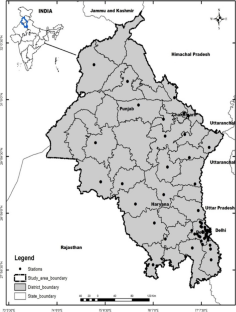




















Similar content being viewed by others
Data Availability
The data will be made available by the corresponding author on request.
References
Alam, K., Qureshi, S., & Blaschke, T. (2011). Monitoring spatio-temporal aerosol patterns over Pakistan based on MODIS, TOMS and MISR satellite data and a HYSPLIT model. Atmospheric Environment, 45(27), 4641–4651. https://doi.org/10.1016/j.atmosenv.2011.05.055
Balakrishnan, K., Dey, S., Gupta, T., Dhaliwal, R. S., Brauer, M., Cohen, A. J., Stanaway, J. D., Beig, G., Joshi, T. K., Aggarwal, A. N., & Sabde, Y. (2019). The impact of air pollution on deaths, disease burden, and life expectancy across the states of India: The Global Burden of Disease Study 2017. Lancet Planetary Health, 3(1), e26–e39. https://doi.org/10.1016/S2542-5196(18)30261-4
Bangar, V., Mishra, A. K., Jangid, M., & Rajput, P. (2021). Elemental characteristics and source-apportionment of PM2. 5 during the post-monsoon season in Delhi, India. Frontiers in Sustainable Cities, 3, 18. https://doi.org/10.3389/frsc.2021.648551
Beig, G., Sahu, S. K., Singh, V., Tikle, S., Sobhana, S. B., Gargeva, P., Ramakrishna, K., Rathod, A., & Murthy, B. S. (2020). Objective evaluation of stubble emission of North India and quantifying its impact on air quality of Delhi. Science of the Total Environment, 709, 136126. https://doi.org/10.1016/j.scitotenv.2019.136126
Bibi, H., Alam, K., Blaschke, T., Bibi, S., & Iqbal, M. J. (2016). Long-term (2007–2013) analysis of aerosol optical properties over four locations in the Indo-Gangetic plains. Applied Optics, 55(23), 6199–6211. https://doi.org/10.1364/AO.55.006199
Brauer, M. (2016). Poor air quality kills 5.5 million worldwide annually. Technical report institute for health Matrices and Evaluation. University of British Columbia. https://www.spph.ubc.ca/poor-air-quality-kills-5-5-million-worldwide-annually/. Accessed on 13 Nov 2021
Census of India. (2011). Primary Census Abstract. Director of Census operations National Capital Territory of Delhi.
Chowdhury, S., Dey, S., Tripathi, S. N., Beig, G., Mishra, A. K., & Sharma, S. (2017). “Traffic intervention” policy fails to mitigate air pollution in megacity Delhi. Environmental Science & Policy, 74, 8–13. https://doi.org/10.1016/j.envsci.2017.04.018
CPCB. (2009). National Ambient Air Quality Standards, Central Pollution Control Board Notification, New Delhi, 18th November, 2009 No.B-29016/20/90/PCI-. Accessed 25 Nov 2020. https://tspcb.cgg.gov.in/Environment/Ambient%20Air%20Quality_Standards_2009.pdf
CPCB. (2010). Air quality monitoring, emission inventory and source apportionment study for Indian cities. Central Pollution Control Board. p 46–67. https://cpcb.nic.in/displaypdf.php?id=RmluYWxOYXRpb25hbFN1bW1hcnkucGRm. Accessed 13 Nov 2021
CPCB (2016). Air pollution in Delhi an analysis. http://cpcbenvis.nic.in/envis_newsletter/air%20pollution%20in%20delhi.pdf. Accessed 13 Nov 2021
Day, S. (2021). Air pollution in rural India: Ignored but not absent. https://www.downtoearth.org.in/blog/pollution/air-pollution-in-rural-india-ignored-but-not-absent-75341. Accessed 26 March 2021
Dey, S., Di Girolamo, L., van Donkelaar, A., Tripathi, S. N., Gupta, T., & Mohan, M. (2012). Variability of outdoor fine particulate (PM2. 5) concentration in the Indian Subcontinent: A remote sensing approach. Remote Sensing of Environment, 127, 153–161. https://doi.org/10.1016/j.rse.2012.08.021
Dhaka, S. K., Kumar, V., Panwar, V., Dimri, A. P., Singh, N., Patra, P. K., Matsumi, Y., Takigawa, M., Nakayama, T., Yamaji, K., & Kajino, M. (2020). PM 2.5 diminution and haze events over Delhi during the COVID-19 lockdown period: An interplay between the baseline pollution and meteorology. Scientific Reports, 10(1), 1–8. https://doi.org/10.1038/s41598-020-70179-8
Dhall, N., Kaur, B., & Som, B. K. (2020). Crop Residue Burning in Haryana: Issues & Suggestive Policy Measures, 11(2), 7–18. http://jmpp.in/wp-content/uploads/2020/08/Neelam-Dhall-Bhavneet-Kaur-and-B.-K.-Som.pdf. Accessed 06-04-2024
Goswani, U. (2020). More to Delhi Pollution than crop burning. The Economic Times, 1–3. https://m.economictimes.com/news/politics-and-nation/more-to-delhispollution-than-crop-burning/articleshow/78891537.cms. Accessed 06-04-2024
Gurjar, B. R., Ravindra, K., & Nagpure, A. S. (2016). Air pollution trends over Indian megacities and their local-to-global implications. Atmospheric Environment, 142, 475–495. https://doi.org/10.1016/j.atmosenv.2016.06.030
Guttikunda, S. K., & Goel, R. (2013). Health impacts of particulate pollution in a megacity—Delhi, India. Environmental Development, 6, 8–20. https://doi.org/10.1016/j.envdev.2012.12.002
Guttikunda, S. K., & Gurjar, B. R. (2012). Role of meteorology in seasonality of air pollution in megacity Delhi. India. Environmental Monitoring and Assessment, 184(5), 3199–3211. https://doi.org/10.1007/s10661-011-2182-8
Hama, S. M., Kumar, P., Harrison, R. M., Bloss, W. J., Khare, M., Mishra, S., Namdeo, A., Sokhi, R., Goodman, P., & Sharma, C. (2020). Four-year assessment of ambient particulate matter and trace gases in the Delhi-NCR region of India. Sustainable Cities and Society, 54, 102003. https://doi.org/10.1016/j.scs.2019.102003
Health Effects Institute. (2020). State of Global Air 2020. Special Report. Boston, MA: Health Effects Institute. https://fundacionio.com/wp-content/uploads/2020/10/soga-2020-report.pdf. Accessed 13 Nov 2021
IQAir. (2021). 2020 World air quality report regions and city ranking. https://www.iqair.com/in-en/world-most-polluted-countries. Accessed 16 Oct 2021
Kanchan, K., Gorai, A. K., & Goyal, P. (2015). A review on air quality indexing system. Asian Journal of Atmospheric Environment, 9(2), 101–113. https://doi.org/10.5572/ajae.2015.9.2.101
Kar, J., Deeter, M. N., Fishman, J., Liu, Z., Omar, A., Creilson, J. K., Trepte, C. R., Vaughan, M. A., & Winker, D. M. (2010). Wintertime pollution over the Eastern Indo-Gangetic Plains as observed from MOPITT, CALIPSO and tropospheric ozone residual data. Atmospheric Chemistry and Physics, 10(24), 12273. https://doi.org/10.5194/acp-10-12273-2010
Kedia, S., Pandey, R., & Malhotra, A. (2020). The impact of stubble burning and poor air quality in India during the time of COVID-19. TERI Newsletter, 1–10. https://www.teriin.org/article/impact-stubble-burning-and-poor-air-quality-india-during-time-covid-19. Accessed 06-06-2024
Khanna, P. (2020). Delhi Decoded: Is stubble burning the main cause for Delhi’s pollution? Livemint, 1–4. https://www.livemint.com/news/india/delhi-decoded-is-stubble-burning-the-main-cause-for-delhi-s-pollution-11602832965910.html.%0A%0A. Accessed 06-04-2024
Kumar, A., Gupta, I., Brandt, J., Kumar, R., Dikshit, A. K., & Patil, R. S. (2016). Air quality mapping using GIS and economic evaluation of health impact for Mumbai city, India. Journal of the Air & Waste Management Association, 66(5), 470–481. https://doi.org/10.1080/10962247.2016.1143887
Laskar, A. H., Maurya, A. S., Singh, V., Gurjar, B. R., & Liang, M. C. (2020). A new perspective of probing the level of pollution in the megacity Delhi affected by crop residue burning using the triple oxygen isotope technique in atmospheric CO2. Environmental Pollution, 263, 114542. https://doi.org/10.1016/j.envpol.2020.114542
Liu, T., Marlier, M. E., DeFries, R. S., Westervelt, D. M., Xia, K. R., Fiore, A. M., Mickley, L. J., Cusworth, D. H., & Milly, G. (2018). Seasonal impact of regional outdoor biomass burning on air pollution in three Indian cities: Delhi, Bengaluru, and Pune. Atmospheric Environment, 172, 83–92. https://doi.org/10.1016/j.atmosenv.2017.10.024
Mahato, D. K., Sankar, T. K., Ambade, B., Mohammad, F., Soleiman, A. A., & Gautam, S. (2023). Burning of municipal solid waste: An invitation for aerosol black carbon and PM2. 5 Over mid–sized city in India. Aerosol Science and Engineering, 1–14. https://doi.org/10.1007/s41810-023-00184-7
Mishra, A. K., Shibata, T., & Srivastava, A. (2014). Synergistic approach for the aerosol monitoring and identification of types over Indo-Gangetic Basin in pre-monsoon season. Aerosol and Air Quality Research, 14(3), 767–782. https://doi.org/10.4209/aaqr.2013.03.0083
Nair, M. M., Bherwani, H., Kumar, S., Gulia, S., Goyal, S.K., & Kumar, R. (2020). Assessment of contribution of agricultural residue burning on air quality of Delhi using remote sensing and modelling tools. Atmospheric Environment, 117504. https://doi.org/10.1016/j.atmosenv.2020.117504
NASA Earthdata. (2020). https://earthdata.nasa.gov/earth-observation-data/near-real466time/near-real-time-versus-standard-products. Accessed 11-12-2023
Omar, A. H., Winker, D. M., Vaughan, M. A., Hu, Y., Trepte, C. R., Ferrare, R. A., Lee, K. P., Hostetler, C. A., Kittaka, C., Rogers, R. R., & Kuehn, R. E. (2009). The CALIPSO automated aerosol classification and lidar ratio selection algorithm. Journal of Atmospheric and Oceanic Technology, 26(10), 1994–2014. https://doi.org/10.1175/2009JTECHA1231.1
Pant, P., Shukla, A., Kohl, S. D., Chow, J. C., Watson, J. G., & Harrison, R. M. (2015). Characterization of ambient PM2. 5 at a pollution hotspot in New Delhi, India and inference of sources. Atmospheric Environment, 109, 178–189. https://doi.org/10.1016/j.atmosenv.2015.02.074
Pant, P., Lal, R. M., Guttikunda, S. K., Russell, A. G., Nagpure, A. S., Ramaswami, A., & Peltier, R. E. (2019). Monitoring particulate matter in India: Recent trends and future outlook. Air Quality, Atmosphere and Health, 12(1), 45–58. https://doi.org/10.1007/s11869-018-0629-6
Pathi, K., & Chhabra, A. (2020). Stubble burning: Why it continues to smother north India. BBC News, 1–5. https://www.bbc.com/news/world-asia-india-54930380. Accessed 06-04-2024
Petersen, H. E. (2019). Delhi’s smog blamed on crop fires – But farmers say they have little choice. The Guardian, 1–6. https://www.theguardian.com/world/2019/nov/08/indian-farmers-have-no-choice-but-to-burn-stubble-and-break-the-law. Accessed 06-04-2024
Rasma, K., Menon, R., Kumar, R., Gadhavi, H., & Sethi, V. (2019). Study of the extent of contribution of regional stubble burning to the air pollution in Delhi-National Capital Region. In: A&WMA's 112th Annual Conference, at Quebec, Canada held on 19th (June 2019).
Ravindra, K., Sidhu, M. K., Mor, S., John, S., & Pyne, S. (2016). Air pollution in India: Bridging the gap between science and policy. Journal of Hazardous, Toxic, and Radioactive Waste, 20(4), A4015003. https://doi.org/10.1061/(ASCE)HZ.2153-5515.0000303
Saxena, P., Sonwani, S., Srivastava, A., Jain, M., Srivastava, A., Bharti, A., Rangra, D., Mongia, N., Tejan, S., & Bhardwaj, S. (2021). Impact of crop residue burning in Haryana on the air quality of Delhi India. Heliyon, 7(5), e06973. https://doi.org/10.1016/j.heliyon.2021.e06973
Shaik, D. S., Kant, Y., Mitra, D., Singh, A., Chandola, H. C., Sateesh, M., Babu, S. S., & Chauhan, P. (2019). Impact of biomass burning on regional aerosol optical properties: A case study over northern India. Journal of Environmental Management, 244, 328–343. https://doi.org/10.1016/j.jenvman.2019.04.025
Shang, K., Xu, L., Liu, X., Yin, Z., Liu, Z., Li, X., Yin, L., & Zheng, W. (2023). Study of urban heat island effect in Hangzhou metropolitan area based on SW-TES algorithm and image dichotomous model. SAGE Open, 13(4), 21582440231208852. https://doi.org/10.1177/21582440231208851
Sharma, S., Zhang, M., Gao, J., Zhang, H., & Kota, S. H. (2020). Effect of restricted emissions during COVID-19 on air quality in India. Science of the Total Environment, 728, 138878. https://doi.org/10.1016/j.scitotenv.2020.138878
Sharma, M., & Dikshit, O. (2016). Comprehensive study on air pollution and green house gases (GHGs) in Delhi. Final report: Air pollution component. Indian Institute of Technology Kanpur. http://environment.delhigovt.nic.in/wps/wcm/connect/735190804acf830c8eec8f09c683c810/Final+Report09Jan2016.pdf?MOD=AJPERES&lmod=1109294014&CACHEID=735190804acf830c8eec8f09c683c810. Accessed 22 Nov 2021
Singh, A., Rastogi, N., Sharma, D., & Singh, D. (2014). Inter and intra-annual variability in aerosol characteristics over northwestern Indo-Gangetic Plain. Aerosol and Air Quality Research, 15(2), 376–386. https://doi.org/10.4209/aaqr.2014.04.0080
Singh, V., Biswal, A., Kesarkar, A. P., Mor, S., & Ravindra, K. (2020). High resolution vehicular PM10 emissions over megacity Delhi: Relative contributions of exhaust and non-exhaust sources. Science of the Total Environment, 699, 134273. https://doi.org/10.1016/j.scitotenv.2019.134273
Singh, D., Dahiya, M., Kumar, R., & Nanda, C. (2021a). Sensors and systems for air quality assessment monitoring and management: A review. Journal of Environmental Management, 289, 112510. https://doi.org/10.1016/j.jenvman.2021.112510
Singh, D., Nanda, C., & Dahiya, M. (2021b). State of air pollutants and related health risk over Haryana India as viewed from satellite platform in COVID-19 lockdown scenario. Spatial Information Research, 1–16. https://doi.org/10.1007/s41324-021-00410-9.
Singh, D., Kundu, N., & Ghosh, S. (2021c). Mapping rice residues burning and generated pollutants using Sentinel-2 data over northern part of India. Remote Sensing Applications: Society and Environment, 22, 100486. https://doi.org/10.1016/j.rsase.2021.100486
Srinivasan, G., Abirami, A. (2020) Mitigation of crop residue burning induced air pollution in New Delhi–A review International. Journal of Engineering Applied Sciences and Technology, 5(8), 282–291. https://doi.org/10.33564/ijeast.2020.v05i08.045
Srivastava, A. K., Tripathi, S. N., Dey, S., Kanawade, V. P., & Tiwari, S. (2012). Inferring aerosol types over the Indo-Gangetic Basin from ground based sunphotometer measurements. Atmospheric Research, 109, 64–75. https://doi.org/10.1016/j.atmosres.2012.02.010
Tao, M., Chen, L., Wang, Z., Tao, J., Che, H., Wang, X., & Wang, Y. (2015). Comparison and evaluation of the MODIS Collection 6 aerosol data in China. Journal of Geophysical Research: Atmospheres, 120(14), 6992–7005. https://doi.org/10.1002/2015JD023360
Tian, H., Pei, J., Huang, J., Li, X., Wang, J., Zhou, B., Qin, Y., & Wang, L. (2020). Garlic and winter wheat identification based on active and passive satellite imagery and the google earth engine in northern china. Remote Sensing, 12(21), 3539. https://doi.org/10.3390/rs12213539
Tyagi, S., Tiwari, S., Mishra, A., Hopke, P. K., Attri, S. D., Srivastava, A. K., & Bisht, D. S. (2016). Spatial variability of concentrations of gaseous pollutants across the National Capital Region of Delhi. India. Atmospheric Pollution Research, 7(5), 808–816. https://doi.org/10.1016/j.apr.2016.04.008
Usmani, M., Kondal, A., Wang, J., & Jutla, A. (2020). Environmental association of burning agricultural biomass in the Indus River Basin. GeoHealth, 4(11). https://doi.org/10.1029/2020GH000281
Vadrevu, K., & Lasko, K. (2018). Intercomparison of MODIS AQUA and VIIRS I-Band fires and emissions in an agricultural landscape—Implications for air pollution research. Remote Sensing, 10(7), 978. https://doi.org/10.3390/rs10070978
Wen, Z., Wang, Q., Ma, Y., Jacinthe, P. A., Liu, G., Li, S., Shang, Y., Tao, H., Fang, C., Lyu, L., & Zhang, B. (2024). Remote estimates of suspended particulate matter in global lakes using machine learning models. International Soil and Water Conservation Research, 12(1), 200–216. https://doi.org/10.1016/j.iswcr.2023.07.002
WHO. (2016). Ambient Air Pollution, (2016). A Global assessment of exposure and burden of disease. Geneva: World Health Organization. http://www.who.int/phe/publications/air-pollution-globalassessment/en/. Accessed 08-07-2022
Winker, D. M., Hunt, W. H., & McGill, M. J. (2007). Initial performance assessment of CALIOP. Geophysical Research Letters, 34(19). https://doi.org/10.1029/2007GL030135
Xu, X., Wang, J., Zeng, J., Spurr, R., Liu, X., Dubovik, O., Li, L., Li, Z., Mishchenko, M. I., Siniuk, A., Holben, B. N. (2015). Retrieval of aerosol microphysical properties from AERONET photopolarimetric measurements 2 A new research algorithm and case demonstration. Journal of Geophysical Research: Atmospheres,120(14), 7079–7098. https://doi.org/10.1002/2015JD023113
Zhang, H., Hu, J., Qi, Y., Li, C., Chen, J., Wang, X., He, J., Wang, S., Hao, J., Zhang, L., & Zhang, L. (2017). Emission characterization, environmental impact, and control measure of PM2. 5 emitted from agricultural crop residue burning in China. Journal of Cleaner Production, 149, 629–635. https://doi.org/10.1016/j.jclepro.2017.02.092
Acknowledgements
The authors acknowledge the National Aeronautics Space Administration (NASA), European Space Agency (ESA), and Central Pollution Control Board (CPCB), Government of India for providing data access. Director, HARSAC is acknowledged for providing a lab facility for this research.
Author information
Authors and Affiliations
Corresponding author
Ethics declarations
Conflict of Interest
The authors declare no competing interests.
Additional information
Publisher's Note
Springer Nature remains neutral with regard to jurisdictional claims in published maps and institutional affiliations.
Highlights
• Ground, model, and satellite data showed traces of burnt biomass.
• The highest pollution level was observed during the peak stubble-burning period.
• Stubble burning contributes significantly to Delhi’s seasonal air pollution.
• Satellite-based observations showed the flow of pollutants towards Delhi.
• Meteorological conditions worsen the pollution level during winter.
Rights and permissions
Springer Nature or its licensor (e.g. a society or other partner) holds exclusive rights to this article under a publishing agreement with the author(s) or other rightsholder(s); author self-archiving of the accepted manuscript version of this article is solely governed by the terms of such publishing agreement and applicable law.
About this article
Cite this article
Kundu, N., Hooda, R.S. & Sandeep Does Stubble Burning Really Contribute in Delhi’s Air Pollution? Evidences from Ground, Model, and Satellite Data. Water Air Soil Pollut 235, 320 (2024). https://doi.org/10.1007/s11270-024-07062-z
Received:
Accepted:
Published:
DOI: https://doi.org/10.1007/s11270-024-07062-z


